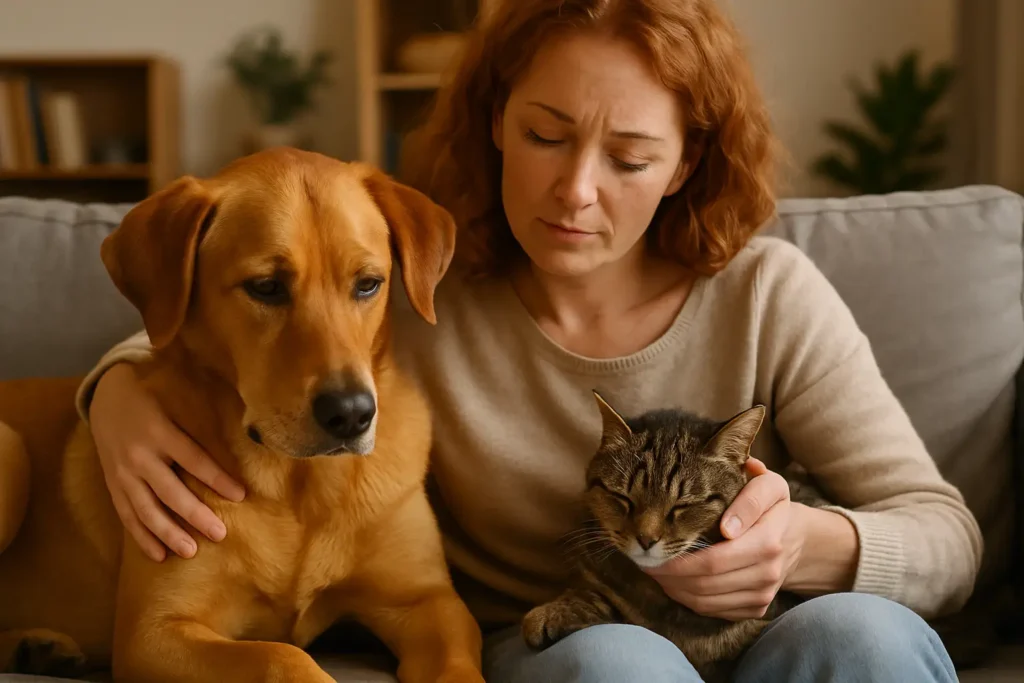How to Recognize and Respect Your Pet’s Emotional Needs
Pets are more than just animals in our homes—they’re emotional beings with complex inner lives. Just like humans, dogs and cats experience happiness, fear, stress, boredom, curiosity, and even loneliness. Meeting their basic needs for food and shelter is essential, but it’s not enough. To truly thrive, pets need emotional connection, stimulation, understanding, and respect.
This guide will help you learn how to recognize the emotional needs of pets and how to meet them in ways that build trust, reduce anxiety, and strengthen your relationship. Whether you share your life with a high-energy dog, a sensitive cat, or a senior companion, understanding their emotional world can transform your connection—and their quality of life.

Why Emotional Well-Being Matters
While pet care often focuses on physical health, emotional wellness is just as vital. Emotional imbalance in pets can lead to:
- Anxiety or depression
- Aggression or withdrawal
- Destructive behavior
- Excessive vocalization or hiding
- Loss of appetite or sleep disturbances
By identifying and responding to emotional cues, you can help your pet feel more secure, happy, and engaged.
Step 1: Observe Your Pet’s Behavior Closely
Every pet is unique, and their emotional needs will show up in different ways. Pay attention to body language, vocalizations, routines, and changes.
Signs Your Pet Is Emotionally Content:
- Relaxed body and posture
- Willingness to play or explore
- Consistent appetite and sleep
- Cuddling or seeking attention
- Calm reactions to everyday sounds and routines
Signs Your Pet May Be Struggling:
- Pacing, restlessness, or hiding
- Aggression or excessive clinginess
- Destructive chewing or scratching
- Overgrooming (especially in cats)
- Avoiding eye contact or physical touch
Behavior is communication. Instead of correcting symptoms, ask: “What is my pet trying to tell me emotionally?”
Step 2: Provide Predictability and Routine
One of the most powerful ways to support your pet emotionally is to create a reliable daily routine. Predictability provides security.
Daily Routines Offer:
- Clear expectations
- Reduced stress during transitions
- Better sleep and eating patterns
- A feeling of control and belonging
Consistency in meals, walks, play, and rest helps your pet feel anchored—especially if they’re anxious or reactive.
Step 3: Respect Your Pet’s Individual Personality
Just like people, pets have different emotional temperaments. Some are social and bold, others are shy or reserved. Bonding depends on meeting them where they are.
Examples:
- A shy cat may not want to be picked up but may enjoy sitting beside you.
- An energetic dog may need active play and training to feel seen.
- A senior pet may want more quiet companionship and gentle routines.
Respecting emotional boundaries—rather than pushing your own agenda—builds deep, lasting trust.
Step 4: Provide Safe Spaces and Retreat Zones
Pets need the ability to retreat and recharge—especially in busy homes.
Set up:
- A quiet crate or bed in a low-traffic area
- Elevated perches for cats
- Covered hideouts or boxes
- Pet-only corners free from noise and chaos
Let your pet retreat without interruption when they’re tired, overstimulated, or stressed.
Step 5: Offer Mental Enrichment and Purpose
Boredom isn’t just inconvenient—it’s emotionally damaging. Dogs and cats are intelligent animals who need purpose and stimulation.
Mental Enrichment Ideas:
- Puzzle feeders and treat-dispensing toys
- Hide-and-seek games with food or toys
- Trick training or obedience practice
- New objects to sniff and explore
- Cat trees, tunnels, or rotating toys
Enrichment should be a daily habit, not an occasional activity. It keeps your pet emotionally balanced and mentally sharp.
Step 6: Pay Attention to Social Needs
Pets are social creatures—even cats, who often prefer selective companionship.
Dogs:
- Need daily human interaction
- Enjoy play, praise, walking, and conversation
- May suffer when left alone for long periods
Cats:
- Value consistent, low-pressure interactions
- Benefit from gentle petting, play, or just sitting nearby
- May form strong attachments to specific people
Avoid isolating pets for long stretches. If you’re busy, leave scent items, talk to them, or set up interactive toys while away.
Step 7: Offer Comfort During Stressful Events
Pets feel our stress—and they have their own, too. Moving homes, loud noises, changes in schedule, or new pets can trigger emotional upheaval.
Help soothe your pet by:
- Staying calm and using a gentle voice
- Providing a safe zone to retreat
- Using calming music or white noise
- Offering familiar objects (blankets, shirts)
- Maintaining routine as much as possible
For loud events like fireworks or storms, prepare a comfort plan in advance.
Step 8: Use Body Language and Touch to Connect
Animals are non-verbal communicators. Learn to “speak” their language through posture, gaze, and physical contact.
Positive Body Language:
- Soft eye contact (don’t stare)
- Slow blinks (for cats)
- Relaxed shoulders and gentle movements
- Sitting at your pet’s level
Soothing Touch Techniques:
- Gentle stroking along the back
- Chest rubs or behind-the-ear scratches
- Grooming or brushing
- Massage (especially for senior pets)
Let your pet initiate contact when possible. Respect a head turn or tail flick as a “no thank you.”
Step 9: Speak With Emotion, Not Just Words
Your pet responds more to how you speak than what you say.
Tips:
- Use a calm, warm tone during bonding
- Be upbeat and encouraging during play or training
- Lower your voice to signal calm or rest
- Avoid yelling—confuses and scares pets
Some pets even associate specific words with feelings (“walk,” “treat,” “good”)—use these intentionally.
Step 10: Acknowledge and Comfort Negative Emotions
Ignoring fear or sadness doesn’t help your pet—it makes them feel invisible.
Instead, try:
- Naming the emotion to yourself (“they’re scared”)
- Offering gentle proximity (not forcing contact)
- Redirecting with calm play or chew toys
- Staying consistent until they re-regulate
Don’t punish your pet for showing emotional distress. Behavior like barking, whining, or hiding is a symptom—not disobedience.
Step 11: Don’t Overwhelm with Attention
Some pet parents love their animals so much, they accidentally crowd them emotionally.
Signs of overwhelm:
- Avoiding touch or walking away
- Excessive grooming or yawning
- Panting or hiding after interaction
Instead of forcing affection, observe and invite interaction. Let them come to you.
Step 12: Validate Their Need for Choice
Empower your pet with small decisions that reinforce emotional autonomy.
Examples:
- Let them choose between two toys
- Offer the choice to go outside or stay
- Provide different textures or locations for rest
- Let your cat decide when to be held
The more control a pet feels, the more relaxed and emotionally secure they’ll become.
Step 13: Adjust for Life Stages
Your pet’s emotional needs evolve over time.
Puppies/kittens:
- Need structure, socialization, and constant reassurance
- May show fear of new sounds or objects—introduce slowly
Adult pets:
- Thrive with routine and clear leadership
- Want play and connection, but also boundaries
Seniors:
- Need comfort, quiet, and patience
- May struggle with anxiety, disorientation, or mobility
Tailor your emotional support to match your pet’s stage of life.
Step 14: Avoid Emotional Triggers (When Possible)
Some environments or actions can create emotional tension.
Common triggers:
- Loud appliances or yelling
- Unpredictable routines
- Lack of hiding or resting space
- Harsh training methods
- Overcrowding or overstimulation
Identify what unsettles your pet and modify their space or exposure to reduce stress.
Step 15: Use Enrichment to Build Confidence
Enrichment isn’t just fun—it’s emotionally therapeutic. It helps insecure pets develop confidence and resilience.
Try:
- Nose work or foraging games
- Obstacle courses or climbing structures
- New textures (blankets, rugs, tunnels)
- Clicker training or trick learning
Challenge with kindness, and always end on a success.
Sample Daily Emotional Support Routine
| Time | Emotional Support Action |
|---|---|
| 7:00 AM | Warm greeting and calm breakfast prep |
| 9:00 AM | Short play or walk with engagement |
| 12:00 PM | Quiet companionship or brushing |
| 3:00 PM | Puzzle toy and solo rest time |
| 6:00 PM | Feeding and conversation |
| 8:00 PM | Cuddle or massage time |
| 10:00 PM | Wind-down and cozy sleep area |
Even 5–10 minutes of focused emotional presence each time can make a world of difference.
Final Thoughts: The Heart of Pet Care
At the center of every thriving pet is a guardian who listens—not just with ears, but with empathy. When we tune into the emotional needs of pets, we’re no longer just feeding, walking, or grooming them—we’re loving them in the language they understand.
You don’t need to be a trainer or behaviorist to build emotional fluency. You simply need consistency, attention, compassion, and the willingness to ask, “How are you feeling, my friend?”
That question—unspoken but deeply felt—is the beginning of a lifetime of trust.




Post Comment